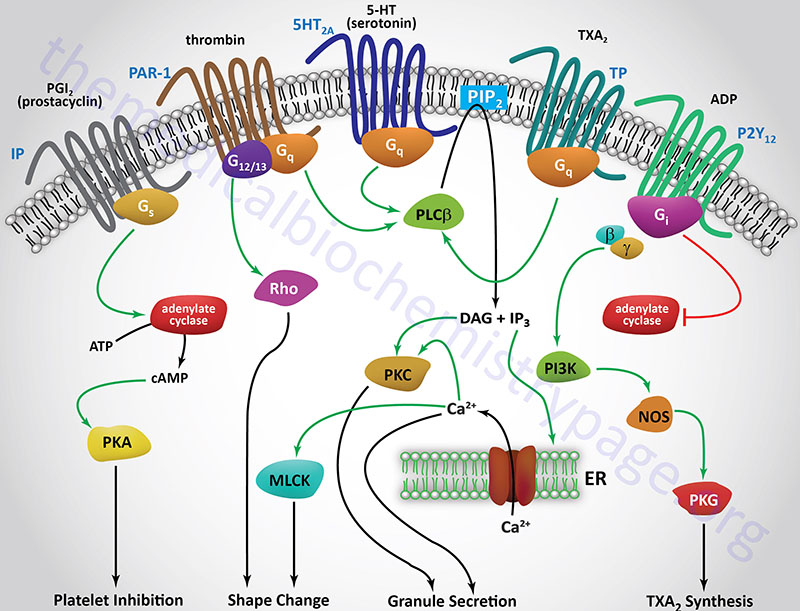Last Updated: October 28, 2025
Introduction to Bernard-Soulier Syndrome
Bernard-Soulier syndrome (BSS) is a bleeding disorder that was first described in 1948 by Jean Bernard and Jean Pierre Soulier. Although the frequency of BSS is approximately 1 in 1,000,000 it is still the second most common inherited bleeding disorder that results as a consequence of defects in platelet function. BSS is characterized by, among other symptoms, the presence of giant platelets. Hence the disorder is also known as Giant Platelet syndrome. In addition to the presence of giant platelets, patients experience a prolonged bleeding time.
Although platelets from these individuals will aggregate in response to the presence of epinephrine, collagen, and/or ADP they will not aggregate in the presence of ristocetin. Ristocetin is an antibiotic isolated from Amycolatopsis lurida that used to be used to treat staphylococcal infections. Ristocetin induces binding of von Willebrand factor to platelet glycoprotein Ib (GPIb) and as a consequence of this activity the compound is used in a diagnostic assay for von Willebrand disease.
Bernard-Soulier syndrome is an autosomal recessive disorder in which most patients have either a decrease or absence of all four proteins of the platelet surface glycoprotein complex identified as the GPIb complex. This platelet glycoprotein complex serves as a binding site for von Willebrand factor (vWF) which then acts as a bridge between sub-endothelial extracellular matrix collagen fibrils exposed at the site of injury and platelets. This interaction between the platelet GPIb complex, vWF, and collagen is absolutely required for platelet adhesion and subsequent aggregation at the site of injury. The absence of platelet aggregation results in failure of the blood coagulation cascade. At least 18 different molecular defects have been identified resulting in Bernard-Soulier syndrome.
Molecular Biology of Bernard-Soulier Syndrome
The GPIb complex is composed of four different proteins encoded by four distinct genes. The proteins are identified as GPIbα, GPIbβ, GPIX, and GPV. The GPIbα and GPIbβ subunits form a disulfide bonded heterodimer. The association of GPV and GPIX proteins into the complex is non-covalent. Mutations in GPIbα result in type A BSS, mutations in GPIbβ result in type B BSS, and mutations in GPIX result in type C BSS.
The GPIbα protein is encoded by the GP1BA gene. The GP1BA gene is located on chromosome 17p13.2 and is composed of 2 exons that encode a 652 amino acid precursor protein with a mass of approximately 145 kDa. The protein is composed of an extracellular domain containing a 24 amino acid leucine-rich segment (7 leucines), a transmembrane domain, and an intracellular domain. The entire coding region of the protein is contained in a single exon.
Each of the four proteins of the GPIb complex contain an extracellular leucine-rich segment. The first identified mutation in BSS was found in the GP1BA gene and there are now at least 11 known alleles of this gene comprising nonsense and missense mutations.
The GPIbβ protein is encoded by the GP1BB gene. The GP1BB gene is located on chromosome 22q11.21 and is composed of 2 exons that encode a 206 amino acid precursor protein with a mass of approximately 22 kDa. This 206 amino acid precursor protein is primarily found in megakaryocytes and platelets. The structure of the GPIbβ protein is similar to that of GPIbα in that there is a 24 amino acid leucine-rich segment in the extracellular domain followed by a transmembrane domain and an intracellular domain. The entire coding region of GPIbβ is encoded in a single exon. Several mutations, including nonsense and missense mutations, have been identified in the GP1BB gene in BSS patients.
The GPV protein is encoded by the GP5 gene. The GP5 gene is located on chromosome 3q29 and is composed of 2 exons that encode a 560 amino acid precursor protein containing a 16 amino acid signal peptide. The mature GPV protein is a 544 amino acid transmembrane protein that consists of an extracellular domain containing 15 tandem repeats of the 24 amino acid leucine-rich segment that is also present in the other proteins of the GPIb complex, a transmembrane domain, and an intracellular domain. The vast majority of the GPV protein is extracellular (504 amino acids) and this region of the protein contains 8 potential sites of glycosylation. The entire protein is encoded in a single exon. Experiments in mice, where the GP5 gene had been knocked out, demonstrated that platelets were of normal size and shape, responded normally to thrombin action, and exhibited wild-type adhesion to vWF. Thus, loss of GPV function in humans is not a likely cause of BSS.
The GPIX protein is encoded by the GP9 gene. The GP9 gene is located on chromosome 3q21.3 and is composed of 5 exons that encode a 177 amino acid precursor protein with a mass of approximately 17 kDa. The structure of the GPIX protein is similar to the other members of the GPIb complex. It is a transmembrane protein with an extracellular domain containing a leucine-rich segment. At least six missense mutations in the GP9 gene have been identified in BSS patients.
Clinical Features of Bernard-Soulier Syndrome
The clinical manifestations of Bernard-Soulier syndrome are similar to those in patients with dysfunctional platelets. These symptoms include mucocutaneous bleeding (bleeding from mucous membranes and skin), gastrointestinal hemorrhage, and purpuric skin bleeding (bleeding from purplish patches on the skin). In female patients there is the additional complication of menorrhagia. Evaluation of Bernard-Soulier patients is done by analysis of platelet number and size. All patients will have some level of thrombocytopenia (decreased platelet number) and platelets that are from 3 to 20 times normal size.
Bleeding times are increased in Bernard-Soulier syndrome but the distinguishing abnormality is the failure of platelet aggregation (agglutination) in the presence of ristocetin. This aggregation defect cannot be corrected by the addition of normal plasma.
Treatment of Bernard-Soulier Syndrome
Treatment of bleeding in Bernard-Soulier patients is accomplished by local application of pressure, topical thrombin, and platelet transfusion. In female patients hormonal management of menses is important.

